Detailed Market Research Report: Bleisure Travellers in Australia
VerifiedAdded on 2021/06/17
|8
|1503
|24
Report
AI Summary
This market research report examines the characteristics, needs, and purchasing behavior of bleisure travellers in Australia. The study investigates the growing trend of combining business and leisure travel, focusing on the profile of these travellers. The report analyzes both secondary data from journals and articles and primary data collected through a survey of 30 Australian business travellers aged 30-50. The findings indicate that millennials and frequent travellers are key demographics for bleisure travel, with preferences varying between younger and older travellers. The research highlights the impact of bleisure on the tourism industry, as these travellers contribute to increased revenue through accommodation, activities, and purchases. The report concludes by emphasizing the significance of bleisure travel and its potential for continued growth, offering valuable insights for businesses in the tourism sector.
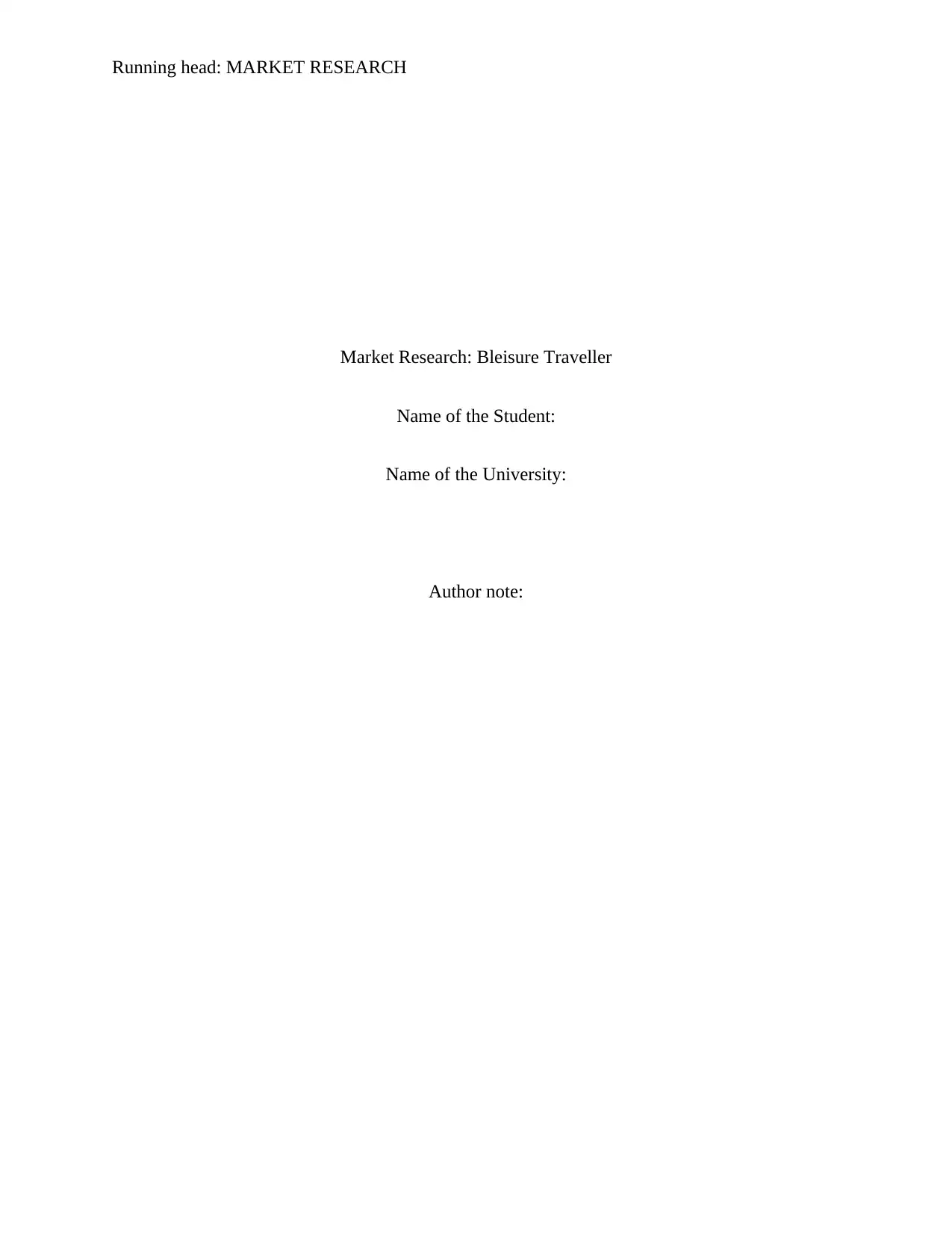
Running head: MARKET RESEARCH
Market Research: Bleisure Traveller
Name of the Student:
Name of the University:
Author note:
Market Research: Bleisure Traveller
Name of the Student:
Name of the University:
Author note:
Paraphrase This Document
Need a fresh take? Get an instant paraphrase of this document with our AI Paraphraser
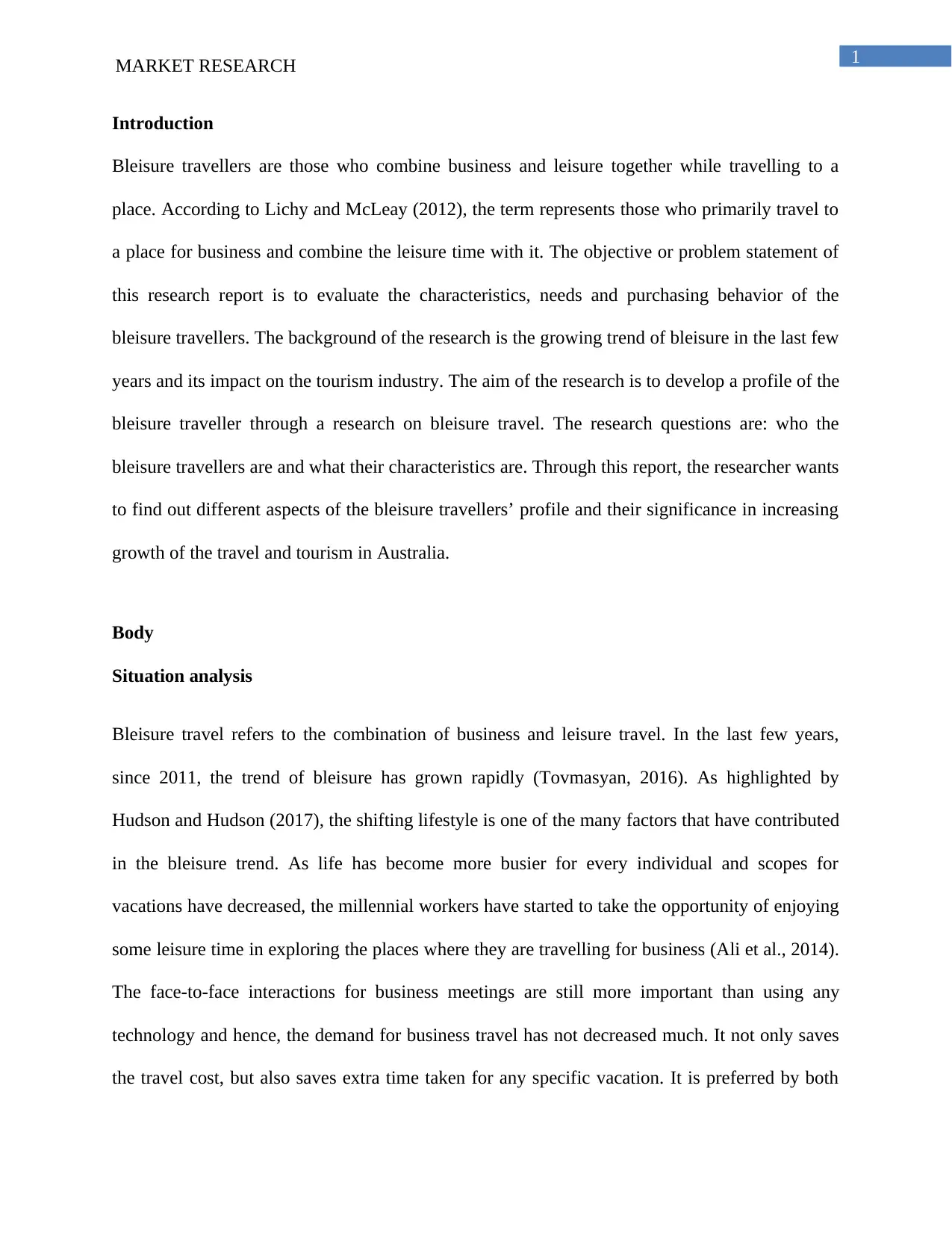
1MARKET RESEARCH
Introduction
Bleisure travellers are those who combine business and leisure together while travelling to a
place. According to Lichy and McLeay (2012), the term represents those who primarily travel to
a place for business and combine the leisure time with it. The objective or problem statement of
this research report is to evaluate the characteristics, needs and purchasing behavior of the
bleisure travellers. The background of the research is the growing trend of bleisure in the last few
years and its impact on the tourism industry. The aim of the research is to develop a profile of the
bleisure traveller through a research on bleisure travel. The research questions are: who the
bleisure travellers are and what their characteristics are. Through this report, the researcher wants
to find out different aspects of the bleisure travellers’ profile and their significance in increasing
growth of the travel and tourism in Australia.
Body
Situation analysis
Bleisure travel refers to the combination of business and leisure travel. In the last few years,
since 2011, the trend of bleisure has grown rapidly (Tovmasyan, 2016). As highlighted by
Hudson and Hudson (2017), the shifting lifestyle is one of the many factors that have contributed
in the bleisure trend. As life has become more busier for every individual and scopes for
vacations have decreased, the millennial workers have started to take the opportunity of enjoying
some leisure time in exploring the places where they are travelling for business (Ali et al., 2014).
The face-to-face interactions for business meetings are still more important than using any
technology and hence, the demand for business travel has not decreased much. It not only saves
the travel cost, but also saves extra time taken for any specific vacation. It is preferred by both
Introduction
Bleisure travellers are those who combine business and leisure together while travelling to a
place. According to Lichy and McLeay (2012), the term represents those who primarily travel to
a place for business and combine the leisure time with it. The objective or problem statement of
this research report is to evaluate the characteristics, needs and purchasing behavior of the
bleisure travellers. The background of the research is the growing trend of bleisure in the last few
years and its impact on the tourism industry. The aim of the research is to develop a profile of the
bleisure traveller through a research on bleisure travel. The research questions are: who the
bleisure travellers are and what their characteristics are. Through this report, the researcher wants
to find out different aspects of the bleisure travellers’ profile and their significance in increasing
growth of the travel and tourism in Australia.
Body
Situation analysis
Bleisure travel refers to the combination of business and leisure travel. In the last few years,
since 2011, the trend of bleisure has grown rapidly (Tovmasyan, 2016). As highlighted by
Hudson and Hudson (2017), the shifting lifestyle is one of the many factors that have contributed
in the bleisure trend. As life has become more busier for every individual and scopes for
vacations have decreased, the millennial workers have started to take the opportunity of enjoying
some leisure time in exploring the places where they are travelling for business (Ali et al., 2014).
The face-to-face interactions for business meetings are still more important than using any
technology and hence, the demand for business travel has not decreased much. It not only saves
the travel cost, but also saves extra time taken for any specific vacation. It is preferred by both
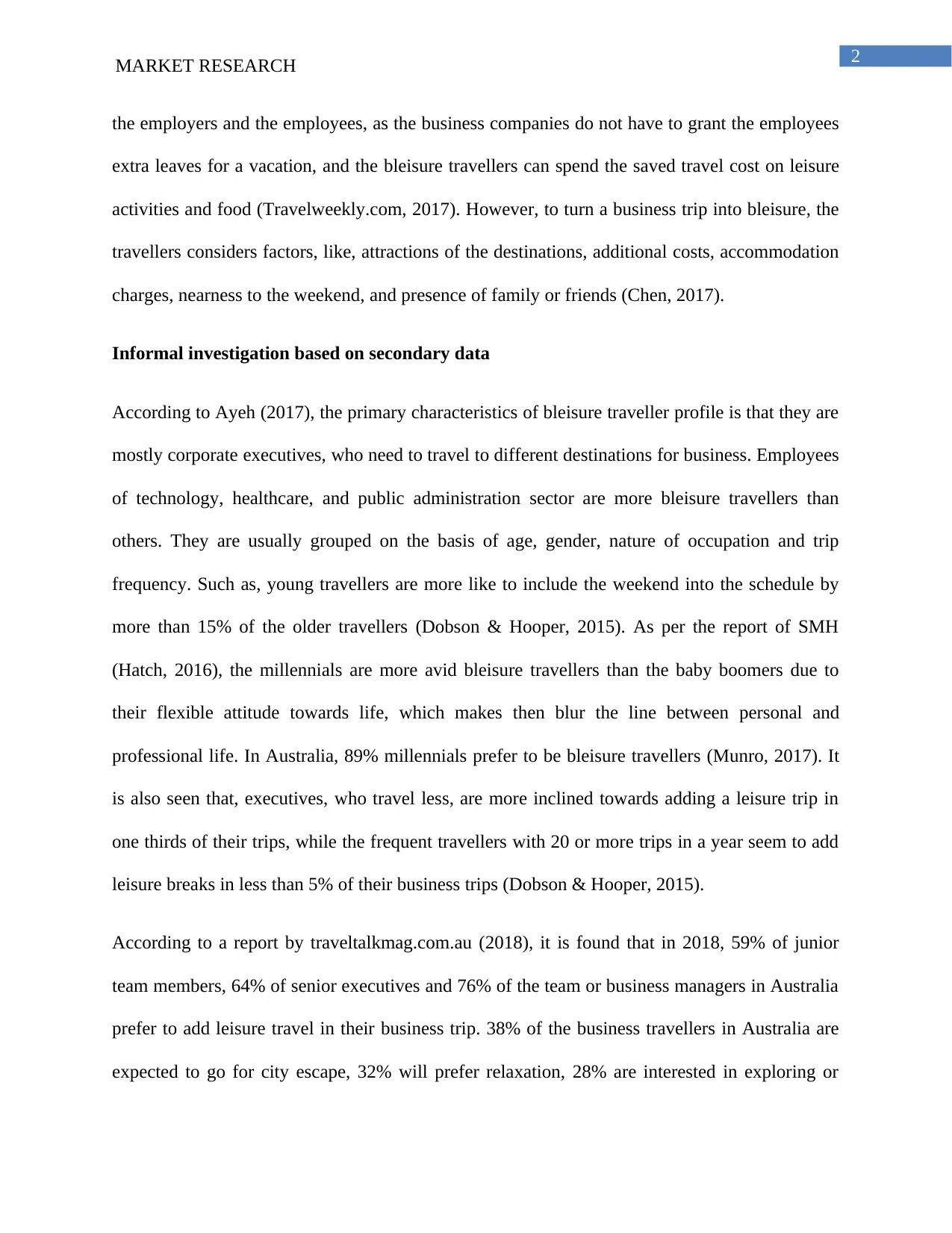
2MARKET RESEARCH
the employers and the employees, as the business companies do not have to grant the employees
extra leaves for a vacation, and the bleisure travellers can spend the saved travel cost on leisure
activities and food (Travelweekly.com, 2017). However, to turn a business trip into bleisure, the
travellers considers factors, like, attractions of the destinations, additional costs, accommodation
charges, nearness to the weekend, and presence of family or friends (Chen, 2017).
Informal investigation based on secondary data
According to Ayeh (2017), the primary characteristics of bleisure traveller profile is that they are
mostly corporate executives, who need to travel to different destinations for business. Employees
of technology, healthcare, and public administration sector are more bleisure travellers than
others. They are usually grouped on the basis of age, gender, nature of occupation and trip
frequency. Such as, young travellers are more like to include the weekend into the schedule by
more than 15% of the older travellers (Dobson & Hooper, 2015). As per the report of SMH
(Hatch, 2016), the millennials are more avid bleisure travellers than the baby boomers due to
their flexible attitude towards life, which makes then blur the line between personal and
professional life. In Australia, 89% millennials prefer to be bleisure travellers (Munro, 2017). It
is also seen that, executives, who travel less, are more inclined towards adding a leisure trip in
one thirds of their trips, while the frequent travellers with 20 or more trips in a year seem to add
leisure breaks in less than 5% of their business trips (Dobson & Hooper, 2015).
According to a report by traveltalkmag.com.au (2018), it is found that in 2018, 59% of junior
team members, 64% of senior executives and 76% of the team or business managers in Australia
prefer to add leisure travel in their business trip. 38% of the business travellers in Australia are
expected to go for city escape, 32% will prefer relaxation, 28% are interested in exploring or
the employers and the employees, as the business companies do not have to grant the employees
extra leaves for a vacation, and the bleisure travellers can spend the saved travel cost on leisure
activities and food (Travelweekly.com, 2017). However, to turn a business trip into bleisure, the
travellers considers factors, like, attractions of the destinations, additional costs, accommodation
charges, nearness to the weekend, and presence of family or friends (Chen, 2017).
Informal investigation based on secondary data
According to Ayeh (2017), the primary characteristics of bleisure traveller profile is that they are
mostly corporate executives, who need to travel to different destinations for business. Employees
of technology, healthcare, and public administration sector are more bleisure travellers than
others. They are usually grouped on the basis of age, gender, nature of occupation and trip
frequency. Such as, young travellers are more like to include the weekend into the schedule by
more than 15% of the older travellers (Dobson & Hooper, 2015). As per the report of SMH
(Hatch, 2016), the millennials are more avid bleisure travellers than the baby boomers due to
their flexible attitude towards life, which makes then blur the line between personal and
professional life. In Australia, 89% millennials prefer to be bleisure travellers (Munro, 2017). It
is also seen that, executives, who travel less, are more inclined towards adding a leisure trip in
one thirds of their trips, while the frequent travellers with 20 or more trips in a year seem to add
leisure breaks in less than 5% of their business trips (Dobson & Hooper, 2015).
According to a report by traveltalkmag.com.au (2018), it is found that in 2018, 59% of junior
team members, 64% of senior executives and 76% of the team or business managers in Australia
prefer to add leisure travel in their business trip. 38% of the business travellers in Australia are
expected to go for city escape, 32% will prefer relaxation, 28% are interested in exploring or
⊘ This is a preview!⊘
Do you want full access?
Subscribe today to unlock all pages.

Trusted by 1+ million students worldwide
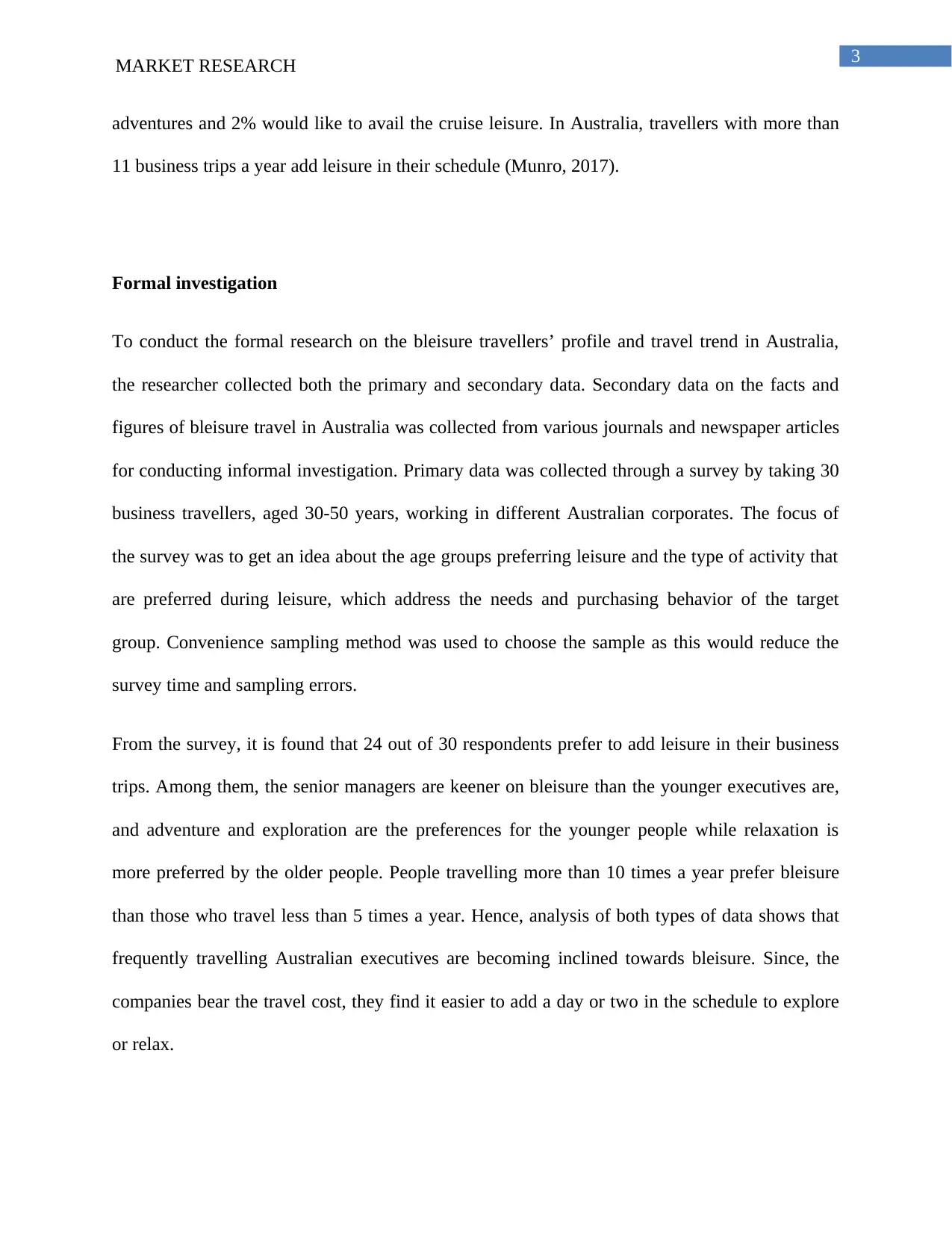
3MARKET RESEARCH
adventures and 2% would like to avail the cruise leisure. In Australia, travellers with more than
11 business trips a year add leisure in their schedule (Munro, 2017).
Formal investigation
To conduct the formal research on the bleisure travellers’ profile and travel trend in Australia,
the researcher collected both the primary and secondary data. Secondary data on the facts and
figures of bleisure travel in Australia was collected from various journals and newspaper articles
for conducting informal investigation. Primary data was collected through a survey by taking 30
business travellers, aged 30-50 years, working in different Australian corporates. The focus of
the survey was to get an idea about the age groups preferring leisure and the type of activity that
are preferred during leisure, which address the needs and purchasing behavior of the target
group. Convenience sampling method was used to choose the sample as this would reduce the
survey time and sampling errors.
From the survey, it is found that 24 out of 30 respondents prefer to add leisure in their business
trips. Among them, the senior managers are keener on bleisure than the younger executives are,
and adventure and exploration are the preferences for the younger people while relaxation is
more preferred by the older people. People travelling more than 10 times a year prefer bleisure
than those who travel less than 5 times a year. Hence, analysis of both types of data shows that
frequently travelling Australian executives are becoming inclined towards bleisure. Since, the
companies bear the travel cost, they find it easier to add a day or two in the schedule to explore
or relax.
adventures and 2% would like to avail the cruise leisure. In Australia, travellers with more than
11 business trips a year add leisure in their schedule (Munro, 2017).
Formal investigation
To conduct the formal research on the bleisure travellers’ profile and travel trend in Australia,
the researcher collected both the primary and secondary data. Secondary data on the facts and
figures of bleisure travel in Australia was collected from various journals and newspaper articles
for conducting informal investigation. Primary data was collected through a survey by taking 30
business travellers, aged 30-50 years, working in different Australian corporates. The focus of
the survey was to get an idea about the age groups preferring leisure and the type of activity that
are preferred during leisure, which address the needs and purchasing behavior of the target
group. Convenience sampling method was used to choose the sample as this would reduce the
survey time and sampling errors.
From the survey, it is found that 24 out of 30 respondents prefer to add leisure in their business
trips. Among them, the senior managers are keener on bleisure than the younger executives are,
and adventure and exploration are the preferences for the younger people while relaxation is
more preferred by the older people. People travelling more than 10 times a year prefer bleisure
than those who travel less than 5 times a year. Hence, analysis of both types of data shows that
frequently travelling Australian executives are becoming inclined towards bleisure. Since, the
companies bear the travel cost, they find it easier to add a day or two in the schedule to explore
or relax.
Paraphrase This Document
Need a fresh take? Get an instant paraphrase of this document with our AI Paraphraser
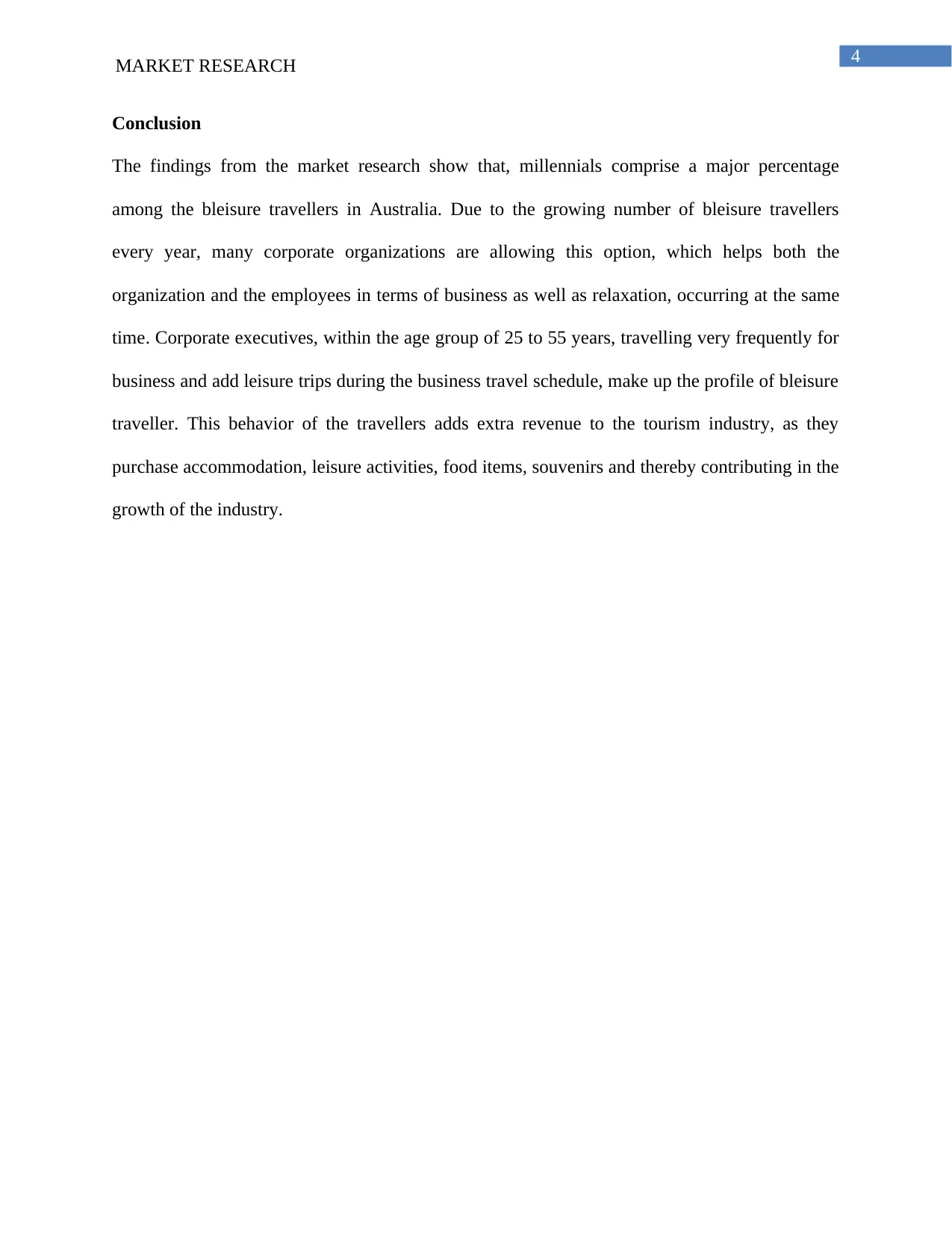
4MARKET RESEARCH
Conclusion
The findings from the market research show that, millennials comprise a major percentage
among the bleisure travellers in Australia. Due to the growing number of bleisure travellers
every year, many corporate organizations are allowing this option, which helps both the
organization and the employees in terms of business as well as relaxation, occurring at the same
time. Corporate executives, within the age group of 25 to 55 years, travelling very frequently for
business and add leisure trips during the business travel schedule, make up the profile of bleisure
traveller. This behavior of the travellers adds extra revenue to the tourism industry, as they
purchase accommodation, leisure activities, food items, souvenirs and thereby contributing in the
growth of the industry.
Conclusion
The findings from the market research show that, millennials comprise a major percentage
among the bleisure travellers in Australia. Due to the growing number of bleisure travellers
every year, many corporate organizations are allowing this option, which helps both the
organization and the employees in terms of business as well as relaxation, occurring at the same
time. Corporate executives, within the age group of 25 to 55 years, travelling very frequently for
business and add leisure trips during the business travel schedule, make up the profile of bleisure
traveller. This behavior of the travellers adds extra revenue to the tourism industry, as they
purchase accommodation, leisure activities, food items, souvenirs and thereby contributing in the
growth of the industry.
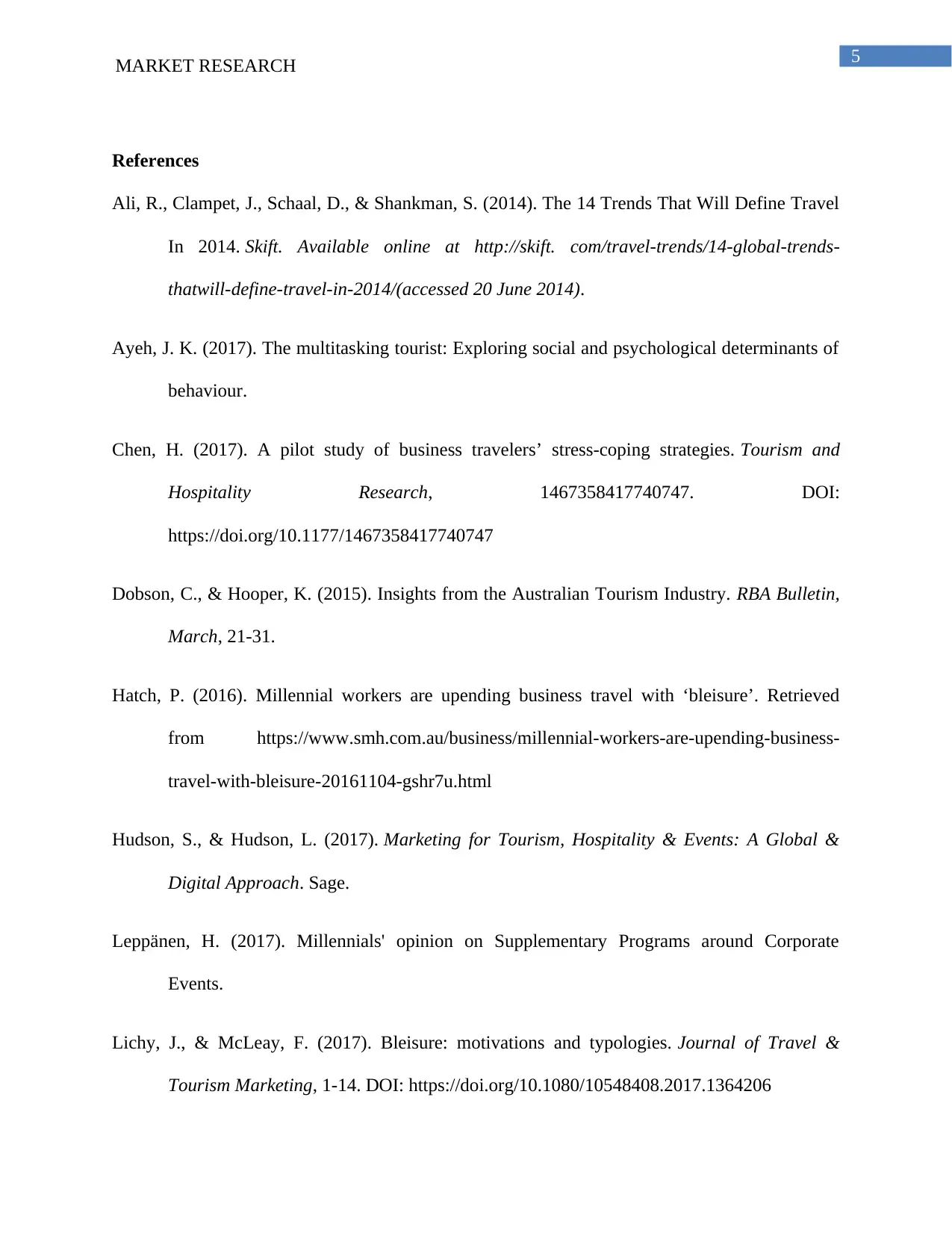
5MARKET RESEARCH
References
Ali, R., Clampet, J., Schaal, D., & Shankman, S. (2014). The 14 Trends That Will Define Travel
In 2014. Skift. Available online at http://skift. com/travel-trends/14-global-trends-
thatwill-define-travel-in-2014/(accessed 20 June 2014).
Ayeh, J. K. (2017). The multitasking tourist: Exploring social and psychological determinants of
behaviour.
Chen, H. (2017). A pilot study of business travelers’ stress-coping strategies. Tourism and
Hospitality Research, 1467358417740747. DOI:
https://doi.org/10.1177/1467358417740747
Dobson, C., & Hooper, K. (2015). Insights from the Australian Tourism Industry. RBA Bulletin,
March, 21-31.
Hatch, P. (2016). Millennial workers are upending business travel with ‘bleisure’. Retrieved
from https://www.smh.com.au/business/millennial-workers-are-upending-business-
travel-with-bleisure-20161104-gshr7u.html
Hudson, S., & Hudson, L. (2017). Marketing for Tourism, Hospitality & Events: A Global &
Digital Approach. Sage.
Leppänen, H. (2017). Millennials' opinion on Supplementary Programs around Corporate
Events.
Lichy, J., & McLeay, F. (2017). Bleisure: motivations and typologies. Journal of Travel &
Tourism Marketing, 1-14. DOI: https://doi.org/10.1080/10548408.2017.1364206
References
Ali, R., Clampet, J., Schaal, D., & Shankman, S. (2014). The 14 Trends That Will Define Travel
In 2014. Skift. Available online at http://skift. com/travel-trends/14-global-trends-
thatwill-define-travel-in-2014/(accessed 20 June 2014).
Ayeh, J. K. (2017). The multitasking tourist: Exploring social and psychological determinants of
behaviour.
Chen, H. (2017). A pilot study of business travelers’ stress-coping strategies. Tourism and
Hospitality Research, 1467358417740747. DOI:
https://doi.org/10.1177/1467358417740747
Dobson, C., & Hooper, K. (2015). Insights from the Australian Tourism Industry. RBA Bulletin,
March, 21-31.
Hatch, P. (2016). Millennial workers are upending business travel with ‘bleisure’. Retrieved
from https://www.smh.com.au/business/millennial-workers-are-upending-business-
travel-with-bleisure-20161104-gshr7u.html
Hudson, S., & Hudson, L. (2017). Marketing for Tourism, Hospitality & Events: A Global &
Digital Approach. Sage.
Leppänen, H. (2017). Millennials' opinion on Supplementary Programs around Corporate
Events.
Lichy, J., & McLeay, F. (2017). Bleisure: motivations and typologies. Journal of Travel &
Tourism Marketing, 1-14. DOI: https://doi.org/10.1080/10548408.2017.1364206
⊘ This is a preview!⊘
Do you want full access?
Subscribe today to unlock all pages.

Trusted by 1+ million students worldwide
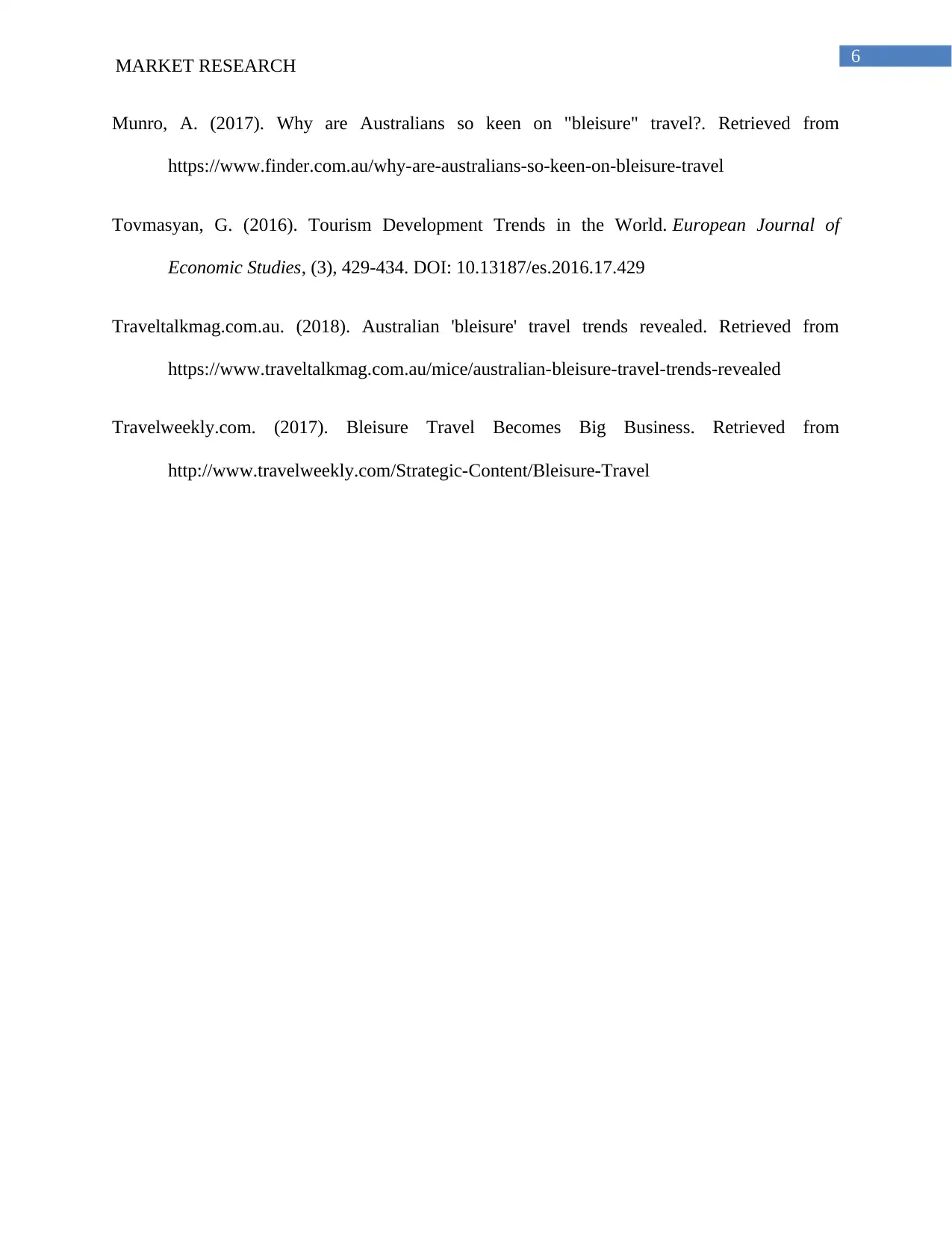
6MARKET RESEARCH
Munro, A. (2017). Why are Australians so keen on "bleisure" travel?. Retrieved from
https://www.finder.com.au/why-are-australians-so-keen-on-bleisure-travel
Tovmasyan, G. (2016). Tourism Development Trends in the World. European Journal of
Economic Studies, (3), 429-434. DOI: 10.13187/es.2016.17.429
Traveltalkmag.com.au. (2018). Australian 'bleisure' travel trends revealed. Retrieved from
https://www.traveltalkmag.com.au/mice/australian-bleisure-travel-trends-revealed
Travelweekly.com. (2017). Bleisure Travel Becomes Big Business. Retrieved from
http://www.travelweekly.com/Strategic-Content/Bleisure-Travel
Munro, A. (2017). Why are Australians so keen on "bleisure" travel?. Retrieved from
https://www.finder.com.au/why-are-australians-so-keen-on-bleisure-travel
Tovmasyan, G. (2016). Tourism Development Trends in the World. European Journal of
Economic Studies, (3), 429-434. DOI: 10.13187/es.2016.17.429
Traveltalkmag.com.au. (2018). Australian 'bleisure' travel trends revealed. Retrieved from
https://www.traveltalkmag.com.au/mice/australian-bleisure-travel-trends-revealed
Travelweekly.com. (2017). Bleisure Travel Becomes Big Business. Retrieved from
http://www.travelweekly.com/Strategic-Content/Bleisure-Travel
Paraphrase This Document
Need a fresh take? Get an instant paraphrase of this document with our AI Paraphraser
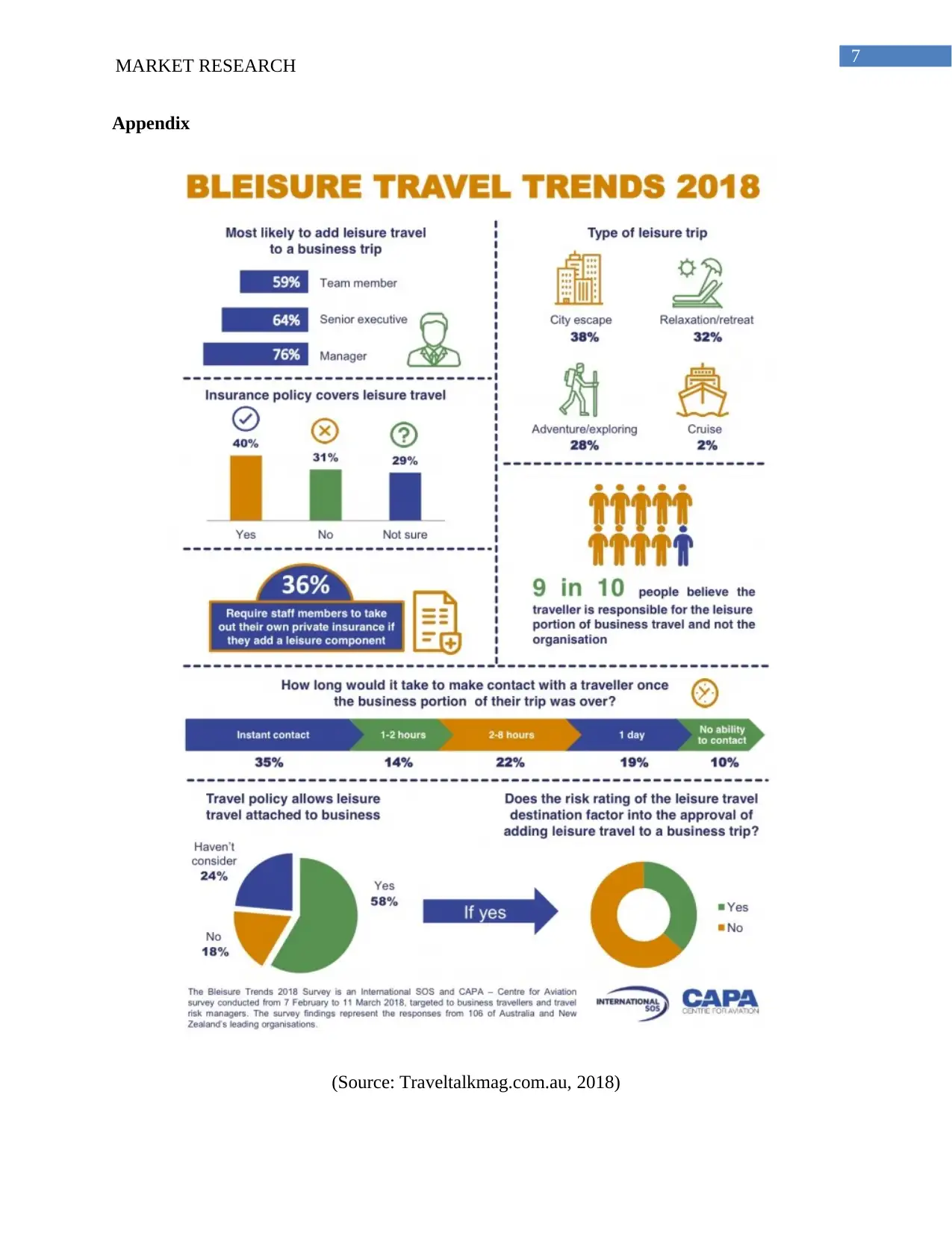
7MARKET RESEARCH
Appendix
(Source: Traveltalkmag.com.au, 2018)
Appendix
(Source: Traveltalkmag.com.au, 2018)
1 out of 8
Related Documents
Your All-in-One AI-Powered Toolkit for Academic Success.
+13062052269
info@desklib.com
Available 24*7 on WhatsApp / Email
![[object Object]](/_next/static/media/star-bottom.7253800d.svg)
Unlock your academic potential
Copyright © 2020–2025 A2Z Services. All Rights Reserved. Developed and managed by ZUCOL.





